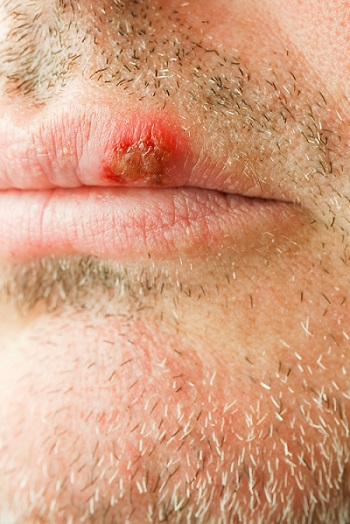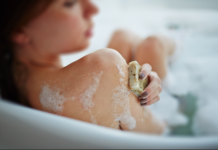What Are They?
Cold sores, also known as fever blisters, are caused by herpes simplex virus 1 (HSV-1). The virus is passed from person to person by saliva (either directly, or by drinking from the same glass or cup), or by skin contact. Cold sores usually appear as tiny blisters on the lip. About 8 out of 10 people have the virus that causes cold sores. Most people are infected before the age of 10.
After the first infection, the virus remains dormant (inactive) in the nerves of the face. In many people, the virus becomes active again from time to time. When this happens, cold sores appear. HSV-1 can become active again because of a cold or fever. The virus is an opportunist, and takes advantage of an immune system which may be fighting other battles.
For example, stress can cause cold sores. This includes both mental and emotional stress. Dental procedures, physical illness, trauma to the lips, or sun exposure can allow the virus to activate. HSV-1 can also infect the eyes, the skin of the fingers and the genitals. However, most genital herpes infections are caused by herpes simplex type 2 (HSV-2).
HSV-1 has the ability to cause serious illness in those who have other health problems, especially in those who have immune systems weakened by illness or medicines they are taking.

Symptoms
Those infected with HSV-1 for the first time may have fever, headache, nausea and vomiting. They may have painful swelling and open sores in the mouth. Some have a sore throat. These symptoms usually begin about a week after exposure to someone with HPV-1.
Cold sores can again appear if the virus is reactivated later in life. They may occur after a period of illness, sunlight exposure, dental procedures, stress, or poor nutrition. Sometimes they occur for no apparent reason.
The border of the lip is the most common location for cold sores to appear. They may occasionally occur inside the mouth as well. This location is more frequently associated with those who have a weakened immune system or other medical conditions.
The first sign of a cold sore is tingling, burning or itching. This is followed by swelling or redness. Within 24 to 48 hours, one or more tiny blisters (“fever blisters”) appear. These blisters pop and form painful sores (“cold sores”). The sores are eventually covered by crusts, which look like scabs. The crusts are shed and form again while the sore heals.
Diagnosis is usually made clinically. When first infected with HSV-1, symptoms can last for 7-14 days. Cold sores usually crust within 4 days and heal completely within 10-14 days.
Here is a brief and informative video about HSV-1:
Prescription Medication
Many have been treated for HPV-1 with antivirals such as acyclovir (Zovirax), famciclovir (Famvir) or Valacyclovir (Valtrex). These drugs cannot eliminate the virus in our body, but they can shorten the time one has active cold sores. They need to be taken at the earliest feeling of a cold sore beginning for best results. If you expect to encounter a known trigger, taking one of these medicines before and during this time may prevent a flare-up. Timing is important with these antivirals. If taken after a cold sore has formed they are of little help.
What is the Best Natural Remedy?
I have prescribed the antivirals mentioned above to many patients over the years. They usually work pretty well. If you have taken them, chances are you had a good experience.
In recent years, I have focused on natural treatments to boost the immune system to fight, and prevent, HPV-1 naturally. There are 2 methods I recommend. If flare-ups are more than a year apart, taking a natural immune booster at the earliest sign of a flare-up may be the way to go. If flare-ups are more frequent, I recommend taking a natural immune booster on a daily basis. My patients who take a daily immune booster have a greatly reduced frequency of not only cold sores but also colds and flu.
Exactly how does this unique, natural immune booster formula work? I am so glad you asked that question! Please read on about a wonderful immune system booster known as….
VIRA-CALM
Vira-Calm is a powerful, safe and effecitve combination of key nutrients and botanical extracts that provide immediate support for immune challenges. Vira-Calm boosts immune defense by providing nutrients such as L-lysine, vitamins A and C, pantothenic acid, B12, and zinc. Vira-Calm includes the synergistic blend of botanical extracts black elderberry, astralagus, echinacea, and andrographis, all of which have been used traditionally for their clinically effective, immune-modulating properties.
Overview
Our body’s immune system is a complex and dynamic defense system that comes to our rescue at the first sign of exposure to an outside invader. The dynamic nature of the immune system means that all factors that affect health need to be addressed in order for it to function at peak performance. The immune system is very sensitive to nutrient deficiencies. While vitamin deficiencies can compromise the immune system, consuming immune enhancing nutrients and botanicals can support and strengthen your body’s immune response. Vira-Calm’s synergistic formula significantly boosts immune cell function including antibody response, natural killer (NK) cell activity, thymus hormone secretions, and T-cell activation. Vira-Calm also helps soothe throat irritations and reduce nasal secretions, and promotes a healthy inflammatory balance by increasing antioxidant levels throughout the body.
Immune Nutrition Base
Vira-Calm contains the synergistic nutrient blend of zinc, vitamin C, vitamin A, L-lysine and pantothenic acid which each play a major role in maintaining a healthy, functioning immune system.
Zinc
Zinc is a mineral that works synergistically with vitamin A in activating thymic factor, a thymus hormone with vital immune supporting properties.{1} Maintaining optimal zinc levels also helps maintain helper T-cell lymphocyte function, NK cell activity, macrophage function, and antibody production.{2}
Vitamin C
Vitamin C is well known for its ability to support immune response. Vitamin C concentrations decline rapidly in the body during periods of stress. Dietary intake is therefore crucial during immune challenges.{3} Vitamin C has been found to be helpful in supporting specific components of the immune system including natural killer (NK) cell activity and lymphocyte function.{3} Vitamin C also provides antioxidant support by protecting cells against reactive oxygen species that are generated during normal inflammatory responses.{3}
Vitamin A
Vitamin A helps support mucous membranes. When vitamin A is lacking, mucus-producing cells are replaced by keratin-producing cells, and the membranes become tough and more vulnerable to organisms. Vitamin A is a critical immune supporting nutrient.{4} Vitamin A also supports the immune system by stimulating white blood cell function and increasing antibody response.{4}
L-Lysine
L-lysine is an essential amino acid that cannot be synthesized in the body on its own. Lysine must be derived from protein sources in the diet in order for the body to function properly. Many biological functions require lysine, including boosting immune defense. A study conducted in China examined the immunological effects of lysine. Of eighty-eight families included in the study, half received wheat flour fortified with 3 g of lysine per kilogram of flour, the other half received wheat flour without fortification. Those given the fortified flour showed improved immune function, versus the placebo group, specifically showing an increase of CD3 T-cells, IgG, IgA, and IgM {5}
Pantothenic Acid (Vitamin B5)
Pantothenic acid (vitamin B5) is a water-soluble B complex vitamin. D-calcium pantothenate is a heat stable form of B5. About 85% of pantothenic acid in food occurs as a component of coenzyme A (CoA). As a component of CoA, pantothenic acid is essential for the production of energy from carbohydrates, fats and protein. Maintaining optimal pantothenic acid levels is crucial for supporting immune system energy, thymic function and healthy white blood cell levels.{6,7}
Black Elderberry Extract
Black elderberry (Sambucas nigra) has a long history of traditional use among herbalists and is native to Europe, Northern Africa, and Western and Central Asia. Elderberry preparations range from expressed juice to syrup, tea decoction, powdered extract, and powdered extract in the form of lozenges or capsules.{8} The bioactive components of elderberry include the flavonoid anthocyanin.{9} Vira-Calm is standardized to include black elderberry extract with 13% anthocyanins. Black elderberry preparations have also been shown to enhance immune cell killing potential by supporting healthy cytokine production, including IL-8 and IL-10, the cellular pathways used to eliminate foreign invaders. {10}
Astragalus Membranaceus Root Extract
Astragalus membranaceus is native to northern China and has been traditionally used to strengthen the immune system.{11} The root of A. membranaceus is one of the two commonly used species in traditional Chinese medicine. Research has demonstrated the immune-regulating effects of astragalus which include boosting T-dependent antigens, and lymphokine-activated killer (LAK) cells and macrophage activity.{12} Additional studies have demonstrated that A.membranaceus root extract supports immune response by boosting T3, T4 and T4/T8 cell ratios.{13}
How To Take Vira-Calm
For immediate immune support: 1-2 capsules per hour or as recommended by your health care professional. Do not exceed 2 capsules per hour.
For immune maintenance: 2 capsules per day or as recommended by your health care professional.
Whether they are called cold sores or fever blisters, I believe you will find Vira-Calm to be quite effective against them, as so many have discovered!
References
- Dardenne M, Pleau J, Nabarra B, et al. Contribution of zinc and other metals to the biological activity of the serum thymic factor. Proc Natl Acad Sci1982;5370-3.
- PDR Health: Zinc. www.pdrhealth.com.
- Wintergerst ES, Maggini S, Hornig DH. Immune-enhancing role of vitamin C and zinc and effect on clinical conditions. Ann Nutr Metab 2006;50(2):85-94.
- Vitamin A. Integrative Medicine: Integrative Medicine Communications; 2000.
- Zhao W, Zhai F, Zhang D, et al. Lysine-fortified wheat flour improves the nutritional and immunological status of wheat-eating families in northern China. Food Nutr Bull Jun 2004;25(2):123-129
- Melampy RM, Cheng DW, Northrop LC. Effect of pantothenic acid deficiency upon adrenal cortex, thymus, spleen, and circulating lymphocytes in mice. Proc Soc Exp Biol Med1951;76:24-27.
- Mahboob S. Thymic weight in pantothenic acid deficiency. Nutr Metab1976;20:272-277.
- The American Botanical Council. The ABC Clinical Guide to Elder Berry. 2004;http://abc.herbalgram.org/site/DocServer/Elderberry-scr.pdf?docID=165.
- Monograph. Sambucus nigra (elderberry). Altern Med Rev Mar 2005;10(1):51-54.
- Barak V, Birkenfeld S, Halperin T, Kalickman I. The effect of herbal remedies on the production of human inflammatory and anti-inflammatory cytokines. Isr Med Assoc J2002;4(11 Suppl):919-22.
- Tan BK, Vanitha J. Immunomodulatory and antimicrobial effects of some traditional chinese medicinal herbs:a review. Curr Med Chem 2004;11(11):1423-1430.
- Kemper K, Small R. Astragalus (Astragalus membranaceous).1999.http://www.longwoodherbal.org/.
- Sinclair S. Chinese herbs: a clinical review of Astragalus, Ligusticum, and Schizandrae. Altern Med Rev 1998;3(5):338-344.
- Berrett B. Medicinal properties of Echinacea: a critical review. Phytomedicine2003;10:66-896.
- Percival SS. Use of Echinacea in medicine. Biochem Pharmacol 2000;60:155-158.
- Pizzorno JE, Murray MT. Textbook of Natural Medicine. (2013) St. Louis, MO: Churchill Livingstone.
- Cáceres DD, Hancke JL, Burgos RA, et al. Use of visual analogue scale measurements (VAS) to assess the effectiveness of standardized Andrographis paniculata extract SHA-10 in reducing the symptoms of common cold. Phytomedicine 1999;6:217-223.
- Calabrese C, Berman SH, Babish, SH, Babish JG, et al. A phase I trial of andrographolide in HIV positive patients and normal volunteers. Phytother Res 2000; 14:333-338.
- Verma N, Vinayak M. Antioxidant action of Andrographispaniculata on lymphoma. Mol Biol Rep 2008; 35:535-540.








